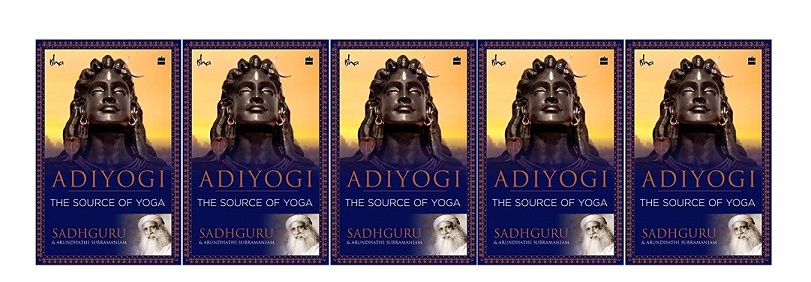Contribute
| Yoga Lingeswara Consecration Unfolding |
Press Release
02/23/2017
Yoga Lingeswara Consecration unfolding
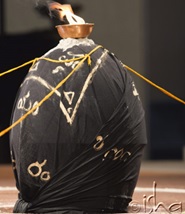
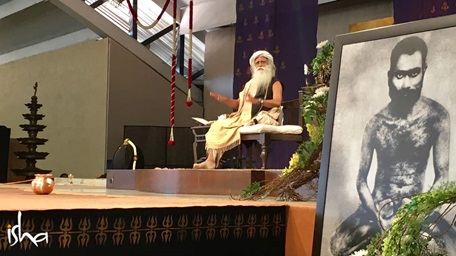
(Photo: Sadhguru with Sadhguru Shri Brahma portrait)
2017 Feb 20: Yoga Lingeswara - A Heartless Yogi
Sadhguru begins to speak about form and geometry. “When formless dimensions of existence take to a form, the geometry of that form determines how that particular form is going to function.”

Sadhguru then offers insight into how the Yogeshwar Linga is energetically structured. “This particular linga has 5 chakras,” he explains. “Each one of them has 16 dimensions. Mooladhara, swadhisthana, manipuraka, vishuddi and agna – no anahata. A heartless yogi.”
“The linga is created for sadhana, not for worship. Of course people are going to worship him, but essentially it’s created for sadhana.”

Sadhguru explains that once the Yogeshwar Linga is fully consecrated, “different people will come and they will touch him in different ways depending upon their orientation…He will ensure that according to the prarabdha that you have, the surface deck of karma that you have, he will make sure you always approach it that way.”
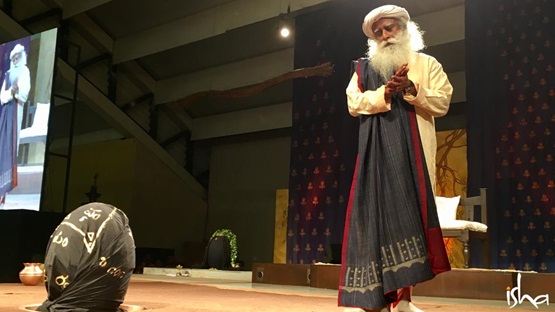
Not Love, But Inclusiveness
The linga, Sadhguru explains, is designed to bring a certain intensity of involvement, “not emotional love – sheer intensity of involvement, where inclusiveness will lead to union.”
“As beautiful as it seems, the love affairs are just a small taste of inclusiveness. This spells poverty of profound experiences in life.”
Explaining why he is using the word “heartless” to describe the linga, Sadhguru says, “A heartless yogi is not brutal – full of anger, rancor. A heartless yogi is pure because he cannot have positive or negative emotion. He knows only yoga, inclusion.”
“When Shiva found his woman, he did not run around the trees, nor the lake…he simply grabbed her, put her here and made her part of himself. This doesn’t look romantic by your standards,” Sadhguru jokes, “because your standards are set by the cinema.”

Sadhguru then begins to speak about the senses, especially sight and hearing. Along with vision and light comes color. “The nature of how we experience color is not the way it is. In many ways, just the reverse of what it is,” he explains. “A certain surface or object, what it throws out becomes its quality.”
On the colors white and black, Sadhguru says “White means the entire light is being reflected. When none of it is being reflected, we are seeing it as black.”
“If you are in situations in life where things that you don’t need are happening around you – wrong types of sounds, cacophony all over, all kinds of situations which are not needed in your life, you must wear white.”
“If you’re in a situation where what’s happening around you is something you want to imbibe, you must wear black.”
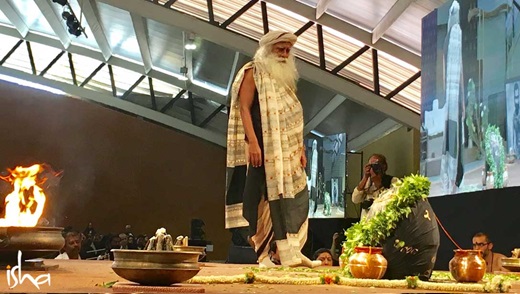
“Unfortunately in western societies, in all the wrong situations they wear black. They have understood that when they wear black, they look a little slimmer than what they are. It is appalling that people wear black when they go to funerals. You must be in whites always, because you don’t want to imbibe death. If you do that, death and the atmosphere of death will stay with you for a long time.”
In Western societies, Sadhguru continues, if people stopped going to office and funerals in black, 15-20% of their psychological problems would come down.

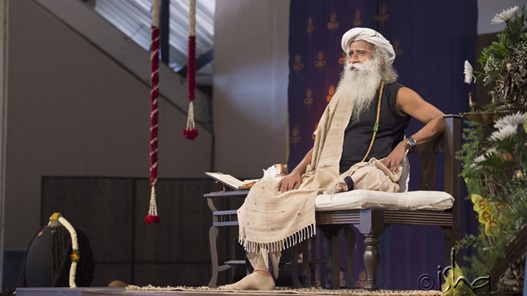
Sadhguru speaks on the boundaries and the nature of the physical. “When we say ‘yogi’,” he explains, “we are talking about that being who has consciously breached the boundaries of individuality.” “The only and only problem in our lives,” he continues, “is that we have become a limited sphere of life.” He says that however beautiful one’s world is, the moment he sees that it is limited, he wants to push the boundary.
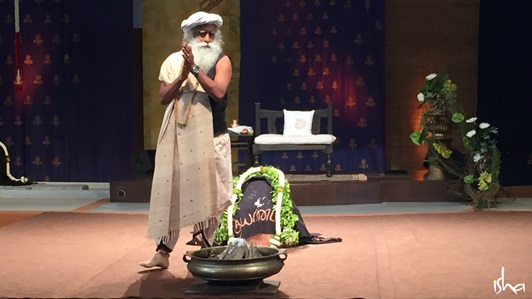
“Adiyogi is not past. He is present. And I want to make sure he is the future of this world.” He explains that everything physical is cyclical in nature referred to as samskara in the yogic tradition, and compares this circular movement to being on a treadmill. Adiyogi, he says, taught them how to get to get off the treadmill so that they are going somewhere. “His physical existence is of no consequence to us,” Sadhguru says, “because he is offering us a way to raise beyond this cyclical nature of life.”

BOOK: Adi Yogi – The Source of Yoga
Sadhguru Jaggi Vasudev, selected for this year's Padma Vibhushan, has now penned a book chronicling Shiva as Adiyogi, the progenitor of yoga, capturing his essence as both emptiness and presence, history and myth, creator and destroyer for a modern audience.
"Shiva does not spell religion. Shiva spells responsibility -- our ability to take our very life process in our hands". -- Sadhguru
'Shi-va' is 'that which is not', a primordial emptiness; Shiva is also the first-ever yogi, Adiyogi, the one who first perceived this emptiness. Adiyogi is symbol and myth, historic figure and living presence, creator and destroyer, outlaw and ascetic, cosmic dancer and passionate lover, all at once.
A book like no other, this extraordinary document is a tribute to Shiva, the Adiyogi, by a living yogi; a chronicle of the progenitor of mysticism by a contemporary mystic. Here science and philosophy merge seamlessly, so do silence and sound, question and answer--to capture the unspeakable enigma of Adiyogi in a spellbinding wave of words and ideas that will leave one entranced, transformed.
Amazon India – Book Link
http://www.amazon.in/Adiyogi-Source-Yoga-Sadhguru/dp/9352643925
Yoga Lingeswara Consecration Blog
Maha Shivarathri Live Blog and Webstream
You may also access this article through our web-site http://www.lokvani.com/












